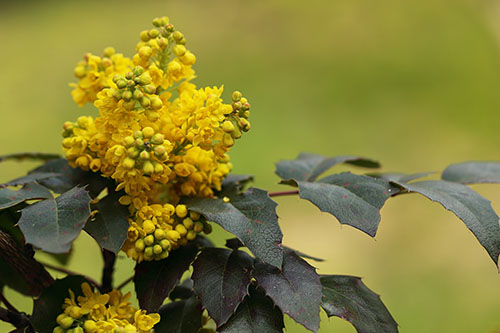Oregon grape root is the Pacific Northwest variety of barberry (Berberis vulgaris). It was used by the indigenous mountain folk of California for all chronic degenerative diseases, especially cancer and arthritis.
Oregon grape and barberry are so similar they are used interchangeably, yet Oregon grape is mild and well tolerated by most body types. It is excellent for hepatitis and jaundice, enlargement of the liver and spleen, gallstones, cholecystitis, poor protein absorption, and gastro-intestinal infections, especially when combined with dandelion root in a tea.
It also treats chronic skin problems caused by blood toxicity such as acne, boils, psoriasis, dry eczema, and others. As well, it’s effective for conjunctivitis, fevers, tumors, arthritis, and rheumatism. If that’s not enough, it may be used for opium and morphine addiction.
Interestingly, Oregon grape treats both constipation and diarrhea. While this may seem contradictory, it remedies a particular type of diarrhea, that which is due to dampness and heat causing either dry difficult stools or yellowish foul-smelling watery stools along with chronic dysentery. It clears prostate conditions and foul-smelling yellowish leucorrhea.
I have found Oregon grape very useful to clear a yellow coat near the root of a tongue, even when nothing else worked, including goldenseal or Chinese scutellaria. (A yellow coat is due to an accumulation of dampness and heat and the root of the tongue means it affects the lower abdominal region.) As well, it clears the effects of coffee, often the cause of that yellow coat.
There are several related varieties of this plant, with similar properties. In the Spanish-American tradition, it is known as yerba de la sangre (“herb of the blood”), indicating its use as a blood purifier (specifically for syphilis), and as a mild diuretic laxative. They also used it similarly to yellow dock for anemia, not because of its significant iron presence, but its ability to release iron stored in the liver. Women would drink it first thing each morning to stimulate menses.
Oregon Grape Root Fact Sheet
Family: Berberidaceae
Also named: Holly grape, mountain grape root, creeping barberry, yerba de la sangre, Mahonia Radix
Energy and flavors: Cool, bitter
Organs and channels affected: Liver, Stomach, Large Intestine
Chemical constituents: The alkaloid berberine
Properties and actions: Alterative, hepatic, laxative; clears Damp-Heat, clears Heat toxins
Contraindications: any coldness in the body, yin or blood deficiency with heat signs, weak metabolism
Dosage and preparation: Standard decoction. Tincture (1:2 @60% ABV fresh; 1:5 @70% ABV dry), 10-30 drops TID.

